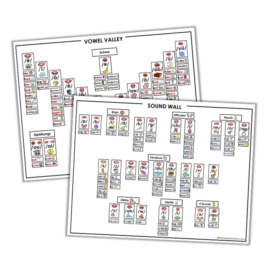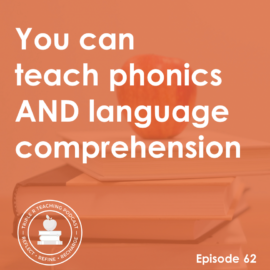
TRT Podcast#24: 5 things to remember when getting started with a sound wall
So you’re thinking of adding a sound wall to your classroom … amazing! Here are five things to keep in mind.
Listen to the episode here
Full episode transcript
Last week, we talked about sound walls, which are visual representations of the approximately forty-four phonemes that are in the English language, as well as the graphemes that we use to spell them. It's a fantastic tool for building phonemic awareness and teaching phoneme-grapheme correspondences. In other words, teaching students the letters that represent particular sounds.
Let's talk about five things to remember when getting started.
Number one, don't feel like you have to put up a sound wall immediately.
When I think about making changes to how you teach reading to align with the science, putting up a sound wall is not at the very top of my list, mainly because it takes a bit of knowledge to use it well, and, if you're not careful, it'll just become wallpaper like your word wall. So don't feel you have to do this right away; you can put it on the back burner for next year.
Number two, educate yourself about what a sound wall is and how to use it to support your students' reading and writing.
There are some excellent sound wall tutorials on YouTube, and you can also sign up for a day's training from Tools for Reading. Their sound wall classes are only offered periodically, but I took one of their six-hour trainings and it was very, very good. I'll give you links to these things in the show notes.
Number three, when you do choose a sound wall to put up on your wall, choose one that you like.
There are a lot of different sound walls you can get. Some use photos of real people's mouths for the sound pictures, others use clip art. Personally, when I created mine for my shop, I used clip art because I like how clean and neat it is. To me, all the different mouth pictures from different children was very distracting and overwhelming. You're going to be using it, so pick one that you like. I'll link to mine in the show notes. If you want one that's actually printed and ready to go and has those mouth pictures of different children, check out Tool for Reading's sound wall pictures, and I will include a link to that in the show notes as well.
Number four, make sure you only turn over the graphemes as you teach them.
A sound wall should be a visual representation of what you've taught. So if I'm teaching kindergarten, I'm probably not going to have any graphemes uncovered under the sound /zh/ because I'm not going to teach them S for /zh/ as in "treasure," right? Underneath the long E sound, I'm probably not going to have I-E uncovered, because I'm not going to teach that to kindergartners. Those are much less common spellings, and I'll save those for later grades.
Number five, make your sound wall a regular part of your instruction.
It should be part of your routine for teaching new phonemes or graphemes, and we're going to look at that more specifically next time.
You can find the show notes for today's episode at themeasuredmom.com/episode24. See you next time!
Sign up to receive email updates
Enter your name and email address below and I'll send you periodic updates about the podcast.
Resources Mentioned
- Sound Wall and Vowel Valley from The Measured Mom
- Tools for Reading sound wall picture cards with real mouth pictures








Wilma
I will definitely try these suggestions! I have a 3rd grader who absolutely hates writing and make excuses not to write during class. Either she has to go to the nurse or to the restroom or somewhere during writing time. When we discussed this at home together, she broke down and just sobbed about how much she hated to write and does not want to do it. This was the situation last year in 2nd grade as well – only now it has gotten much worse. I am very concerned about my child. The 3rd grade teacher explained that my child has to pass a writing test in grade 4. At this point I am very concerned that passing that writing test in grade 4 will not happen. All of her other grades are “A’s.”
Anna Geiger
I’m sorry to hear that your daughter is struggling with this, Wilma! That’s not fun for her or you. Would you send me an email? I can offer some suggestions there and find out more about your situation. You can reach me at hello(at)themeasuredmom(dot)com.